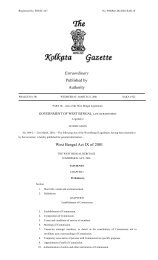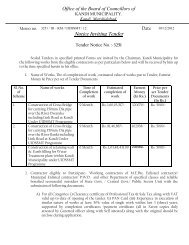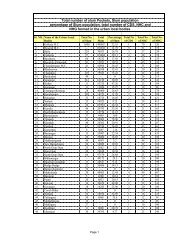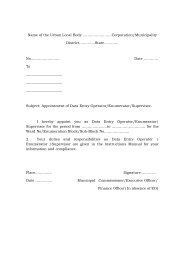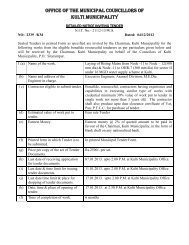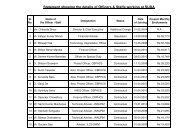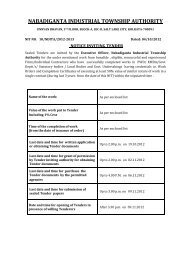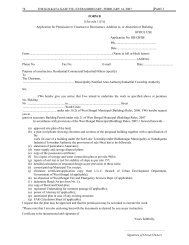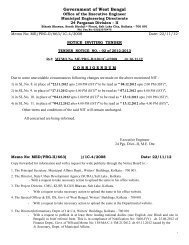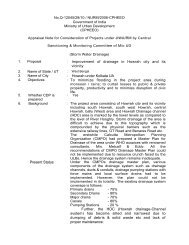Seismic Assessment of Brick Masonry Building - IPRED website
Seismic Assessment of Brick Masonry Building - IPRED website
Seismic Assessment of Brick Masonry Building - IPRED website
Create successful ePaper yourself
Turn your PDF publications into a flip-book with our unique Google optimized e-Paper software.
SEISMIC ASSESSMENT OF BRICK MASONRY BUILDINGSituated Anywhere In <strong>Seismic</strong> Zone IV <strong>of</strong> India1. IntroductionIf you live in a house constructed using brick walls, without reinforced concrete columns, any where in theseismic zones IV <strong>of</strong> India, you should know, for your family’s safety, whether the building will be safe under the nextearthquake or could suffer severe damage. You can yourself assess the level <strong>of</strong> damageability <strong>of</strong> your building by fillinga few simple data in the questionnaire framed herein. But before filling the data, you should go through the guidelineprovided below for better understanding <strong>of</strong> your building and the earthquake behavior <strong>of</strong> such buildings.2. <strong>Seismic</strong> Zone IV and Estimated Maximum Intensity <strong>of</strong> Future EarthquakeBefore using this document, make sure that your building is situated in <strong>Seismic</strong> Zone IV. For ready reference,the districts lying in Zone IV, either wholly or with more than 40% area are listed in Table 1. In seismic zone IV amaximum earthquake Intensity <strong>of</strong> VIII on MSK Intensity Scale is likely to occur. In terms <strong>of</strong> building damage, IntensityVIII is stated to cause the following types <strong>of</strong> damage:-MSK Intensity VIIIMost kutcha buildings constructed using clay walls may be totally destroyed. Most masonry buildingsconstructed using brick walls with mud mortar may also be destroyed. But those constructed using goodcement mortar may only have heavy cracking.<strong>Building</strong>s constructed in sandy soil with high water table are liable to more severe damage than in other areas.Areas <strong>of</strong> Uttarakhand and many areas in Saurashtra are also placed in <strong>Seismic</strong> Zone IV where MSK Intensity VIII hasactually occurred during 1991 Uttarkashi earthquake, 1999 Chamoli earthquake and the 2001 Kachchh earthquakeresulting in wide spread loss <strong>of</strong> life and property due to collapse <strong>of</strong> masonry buildings.3. Basis <strong>of</strong> <strong>Assessment</strong>For the assessment <strong>of</strong> expected seismic performance <strong>of</strong> most <strong>of</strong> the existing load bearing masonry wallbuildings in Zone IV <strong>of</strong> the <strong>Seismic</strong> Zoning Map <strong>of</strong> India, shown in fig. 1, the most direct approach will be to comparethe safety provisions specified in the building code IS: 4326-1993, “Earthquake Resistant Design and Construction <strong>of</strong><strong>Building</strong>s – Code <strong>of</strong> Practice (Second Revision), Bureau <strong>of</strong> Indian Standards” for such buildings with the conditionactually present in an existing building. Where the existing condition is found to comply with the code, it will beconsidered safe and acceptable. But where any existing condition is found deficient, hence non-complying, it will beconsidered as weak and damageable. Such a deficiency will require upgradation or strengthening or retr<strong>of</strong>itting.Here the residential buildings situated in <strong>Seismic</strong> Zone IV only are considered.4. Type <strong>of</strong> <strong>Building</strong> ConstructionThe following building types can be assessed by the simple procedure covered here:(i) <strong>Brick</strong> wall buildings with any mortar and ro<strong>of</strong> type.(ii) Concrete block wall buildings with any mortar and ro<strong>of</strong> type.1
(iii) Fully dressed stone (Ashler masonry)wall buildings with any mortar and ro<strong>of</strong> typeThe number <strong>of</strong> storeys may be one to four only as five storeyed building are not considered in the Code. The buildingmay be fully residential or with mixed use. Only earthquake safety aspects are to be assessed. It is assumed that thebuilding is otherwise safe to carry the vertical weight <strong>of</strong> ro<strong>of</strong> and floor as well as the use-related imposed loads <strong>of</strong>furnishings, partitions, people & the contents like merchandise, <strong>of</strong>fice equipments etc.Table 1:- Districts with more than 40% area falling in <strong>Seismic</strong> Zone IVDISTRICT NAME % AREA DISTRICT NAME % DISTRICT NAME % DISTRICT NAME % AREAAREAAREABIHAR HIMACHAL PRADESH DELHIPaschim Champaran 100 Lahul & Spiti 96.4 Moradabad 100 North West 100Purba 100 Solan 96.2 Rampur 100 North 100Sheohar 92.8 Sirmaur 100 Jyotiba Phule Nagar 100 North East 100Kishanganj 90.8 Shimla 100 Meerut 100 East 100Purnia 95.9 Kinnaur 100 Baghpat 100 New Delhi 100Katihar 100 JAMMU & KASHMIR Ghaziabad 100 Central 100Madhepura 46.8 Anantnag 92.5 Gautam Buddha Nagar 100 West 100Saharsa 55.4 Leh 100 Bulandshahr 100 South West 100Muzaffarpur 92.9 Kargil 100 Aligarh 56.3 South 100Gopal Ganj 100 Doda 100 Mathura 49.4 CHANDIGARH (UT)Siwan 98.8 Udhampur 100 Pilibhit 77.2 Chandigarh 100Saran 100 Punch 100 Kheri 49.9Vaishali 100 Rajuri 100 Bahraich 58.4Samastipur 100 Jammu 100 Shrawasti 93.3Begusarai 100 Kathua 87.1 Balrampur 97.4Khagaria 100 MAHARASHTRA Siddhartnagar 100Bhagalpur 100 Raigarh 73.6 Sant Kabir Nagar 43.7Banka 91.7 Satara 53.6 Maharajganj 100Munger 100 Ratnagiri 54.1 Gorakhpur 57.9Sheikhpura 100 PUNJAB Bareilly 46.1Nalanda 98.2 Gurdaspur 100 Kushinagar 100Lakhisarai 100 Amritsar 81.4 Deoria 71.9Patna 88.1 Kapurthala 100 UTTARAKHANDJamui 73.7 Jalandhar 100 Tehri Garhwal 96.8GUJARAT Hoshiarpur 100 Dehradun 100Banas Kantha 42.3 Nawanshahr 100 Garhwal 96.8Patan 66.1 Rupanagar 100 Champawat 100HARYANA Fatehgarh Sahib 98.1 Nainital 100Panchkula 100 Ludhiana 78.4 Udhan Singh Nagar 100Ambala 89.1 SIKKIM Hardwar 100Yamuna Nagar 100 North 100 WEST BENGALPanipat 66.7 South 100 Darjiling 100Sonipat 83.1 East 100 Jalpaiguri 83.6Rohtak 56.2 West 100 Koch Bihar 88.8Jhajjar 100 UTTAR PRADESH Uttar Dinajpur 100Rewari 100 Saharanpur 100 Dakshin Dinajpur 100Gurgaon 100 Muzaffarnagar 100 North 24 Parganas 64.7Faridabad 100 Bijnor 100 South 24 Parganas 82.82
Fig.1:- <strong>Seismic</strong> Zoning Map <strong>of</strong> India3
5. Factors Considered In <strong>Seismic</strong> Safetyas Per <strong>Building</strong> Code IS: 4326-1993The most important factors consideredin the Code for ensuring seismic safety <strong>of</strong>various category buildings are the following:I) For Safety <strong>of</strong> Walls(i) Mortar used in foundations and walls(ii) Size and placing <strong>of</strong> door, windowopenings in walls(iii) Length <strong>of</strong> wall between cross walls(iv) Height <strong>of</strong> wall above floor to ceiling(v) Unconnected perpendicular walls.(vi) Provision <strong>of</strong> horizontal seismic bands at(a) plinth level(b) door and window lintel level(c) ceiling <strong>of</strong> flat floor/ro<strong>of</strong>, or eave level <strong>of</strong>sloping ro<strong>of</strong>s(d) gable ends and top <strong>of</strong> ridge wall(e) window sill level(vii) Provision <strong>of</strong> vertical steel bar(a) at each corner/junction <strong>of</strong> walls(b) at door & window jambsII) For Safety <strong>of</strong> Ro<strong>of</strong>s or Floors(i) Ro<strong>of</strong>s/floors with prefabricated or precastelements(ii) Cantilever balconies(iii) Ro<strong>of</strong>s/floors with wooden joists withvarious covering elements(iv) Jack arch ro<strong>of</strong> or floors(v) Sloping ro<strong>of</strong>s with sheets or tile covering(vi) Sloping raftered ro<strong>of</strong>sFig.2:- Essential elements for earthquake safety <strong>of</strong>masonry buildings4
6. General guidance about <strong>Seismic</strong> Safety <strong>of</strong> masonry <strong>Building</strong>s• A single storeyed building using one brick thick walls will be relatively safer than three storeyed one. The fourthstorey, if added, will be unsafe, and will make the lower storeys more vulnerable.• Use <strong>of</strong> half – brick thick (10 to 11.5 cm or 4 to 4½” thickness) load bearing walls will make the storey very unsafeduring seismic Intensity VIII on MSK Intensity scale and, if used in 3 rd or 4 th storey, it may have a catastrophicfailure.• Too many window openings make a wall weaker, and use <strong>of</strong> smaller size piers less than 18 inches (45 cm) in widthbetween them will increase the damageability even higher.• Richer cement-sand mortar <strong>of</strong> 1:4 mixture (1 part cement by 4 parts <strong>of</strong> sand) makes the masonry stronger againstearthquake shaking as compared with 1:6 mortar by a factor <strong>of</strong> 2.5 to 3.0. Also 1:6 mortar is stronger than limecinderor lime-surkhi mortar.• Use <strong>of</strong> clay mud mortar produces the weakest masonry. Its strength in dry condition reduces to less than 50 percentwhen the walls get wet during rains. Hence, use <strong>of</strong> good plastering is essential to protect such masonry during rainymonths.• Longer walls between consecutive cross walls are found weaker than shorter walls. The length is controlled forsafety by limiting its length to thickness ratio.• Taller walls between any two floors are found to be weaker than shorter walls. The storey height is controlled bylimiting its height to thickness ratio.• All four walls enclosing a room should be properly connected at each corner. Walls not so connected will easilyseparate at corners and overturn under the earthquake motion.• The most important seismic safety requirement is provision <strong>of</strong> seismic bands in all storeys in all external as well asinternal walls. These bands maintain the integrity <strong>of</strong> the whole building as one unit under earthquake shaking.Besides the earthquake safety, they also increase the stability <strong>of</strong> the walls under the vertical loads.• The ro<strong>of</strong> structure <strong>of</strong> the sloping ro<strong>of</strong>s needs its integrity through bracing and proper connectivity with the walls.Such integrity is automatically provided by reinforced concrete slabs wherever used for floors and the ro<strong>of</strong>.The Indian Standard Code <strong>of</strong> Practice IS: 4326 – 1993 covers all these aspects in detail and gives specificguidance as to how to incorporate them in the earthquake safe construction <strong>of</strong> all types <strong>of</strong> new masonry buildings.7. Form for <strong>Seismic</strong> Safety <strong>Assessment</strong> <strong>of</strong> Housing Units in <strong>Masonry</strong> <strong>Building</strong>s7.1 Guiding Notes for filling the <strong>Assessment</strong> Form(i) Complete all data points. Tick mark columns <strong>of</strong> complying & non-complying as found by compliance.(ii) BB stands for Burned <strong>Brick</strong> Construction and CCB for Cement Concrete Block Construction.(iii) More than 4 storeys are not permitted by Code (IS: 4326 – 1993).(iv) The compressive strength <strong>of</strong> building unit for one and two storey building to be not less than 35 kg/cm 2 , andfor 3 & 4 storeys 50 kg/cm 2 . Note: Red bricks in the Indo-Gangetic plain are normally strong enough and5
complying. But yellow colored bricks are found weaker, hence, non-complying. CCB strength can beascertained from the manufacturers, or determined by testing in laboratory.(v) Normal bricks in India are 230 mm ( 9 inch) in length and CCB 200 mm wide. Load bearing burnt brick wallsare generally 230 mm thick and those using CCB are 200 mm thick. Smaller wall thickness for non-loadbearing partitions and infill burnt brick walls are kept 115 mm (½ brick) or 100 to 150 mm for CCB.(vi) Specified mortar mix is C:S = 1:6 or richer in cement-sand.(vii) Length <strong>of</strong> wall between crosswalls is to be less than 35 xthickness or 8 m maximum.(viii) Height <strong>of</strong> wall fromfloor to ceiling to be not morethan 15 x thickness nor 4m.(ix) Following constraints for doorand window openings arespecified for Zone IV (see fig.3)- End corner distance b 5 =450 mmFig.3:-Opening sizes as per IS: 4326 - 1993- Pier width b 4 = 560 mm- Ratio <strong>of</strong> overall length <strong>of</strong> openings in a wall to its overall length, that is (b 1 + b 2 + b 3 )/L =Is to be less than or equal to 0.5 for one storey building, 0.42 for two storey building, 0.33 for 3 & 4 storeybuilding7.2 The <strong>Assessment</strong> Form<strong>Building</strong> Information:-Address:-Location/Area:-Village/Town:-District:-House Unit under <strong>Assessment</strong>:-Name <strong>of</strong> Owner/Tenant living in the house:-No. <strong>of</strong> storeys in the building including basement if any:-Floor on which the house unit is located: - Ground / First / Second / Third6
S.N(1)Data <strong>of</strong> <strong>Building</strong> under <strong>Assessment</strong>(2)FORM FOR ASSESSING SEISMIC SAFETYRequired as per Code(3)1. Number <strong>of</strong> storeys, S = Equal to or less than 42. Wall building unit: (Tick one)Compressive strength ≥Compressive strength = kg/cm 2BB/CCB (solid)/CCB (Hollow)35 or 50 kg/cm 23. Thickness <strong>of</strong> load bearing walls, tExternal wall =BB = 230 mmCCB = 200 mmInternal wall =4. Mortar used = C:S = 1:6 or richer5. Longest wall in room, L = …….m BB ≤ 8 mCCB ≤ 7 m6. Height <strong>of</strong> wall, floor to ceilingh = ……. mBB = 3.45 mCCB = 3.0 m7. Door, Window openings (See fig.3)Overall (b 1 + b 2 +….)/l,(i) Give max in any room =(ii) b 4 min. =(iii) b 5 min.=8. Floor type (tick mark)a) RC or RB slab,b) Precast RC elements, (tick one)With/without RC screedc) Wood joists with tiles, (tick one)With/without bracingd) Jack arches, (tick one)With/without ties &bracing9. Ro<strong>of</strong> type (tick as present)a) Flat like floor (See item 8 a),b) Sloping trussed, (tick one)With/without bracingc) Sloping raftered, (tick one)With/without ties &bracing10. <strong>Seismic</strong> Bands (tick as present)(i) at plinth provided / not provided(ii) at lintel level provided / not provided(iii) at window provided / not providedsill level(iv) at ceiling or provided / not providedeave level(v) at gable ends provided / not provided(vi) at ridge top provided / not provided11. Vertical bar (tick as present)(i) at external cornersprovided / not provided(ii) at external T-junctionsprovided / not provided(iii) at internal cornersprovided / not provided(iv) at internal T-junctionsprovided / not provided(v) at jambs <strong>of</strong> doorprovided / not provided(vi) at jambs <strong>of</strong> windowsprovided / not providedOne storeyed 0.50Two Storeyed 0.423 or 4 Storeyed 0.33b 4 min 560 mmb 5 min 450 mmOKWith RC screedWith bracingWith ties & bracingOKWith bracingWith ties &bracingRequiredRequiredIn 3 or 4 storey buildingsonlyRequired in cases 8 b, c& 9 b, c.Required in cases 9 b,cRequired in cases 9 b,cRequired in all masonrybuildingsComplyingTick ifNotcomplyingNote: - Record all information for your housing unit and the building <strong>of</strong> which your unit forms part.Action to be taken to save thebuilding from collapse orsevere damage1. Extra upper stories may beremoved.2. For weaker building units,providing RC or steel columnsmay be considered.3. For thinner walls pilasters <strong>of</strong>RC may be designed.4. For weaker mortar case,providing Rc columns &beams may be considered.Note:- In cases 2, 3 & 4 above,strengthening the walls by ferrocementplating <strong>of</strong> by FRP may bean option.5 & 6 Provide buttresses at regularintervals for strengtheningthe wall.7 (i) Consider closing one <strong>of</strong> thewindows or reduce the width<strong>of</strong> window openings byadding additional thickness<strong>of</strong> piers.(ii) & (iii) strengthening the piersby ferro-cement plating.8.(b)Use RC screed withperipheral RC beam in place<strong>of</strong> RC ceiling band8. (c)Introduce cross ties withdiagonal bracing underneaththe floor.8. (d)Provide cross ties welded tothe steel joists along withdiagonal bracing.9(b) Use diagonal bracing in theplane <strong>of</strong> the ties and theprincipal rafters in everyfourth panel.9(c) As in 9 (b)10 (i) Incase the plinth is high say90 cm or higher provideseismic belt.10 (ii) to (vi) Provide seismic belton the walls at the levelwhere seismic band wasrequired.11 (i) to (iv) Provide seismic beltor a vertical bars at thecorners <strong>of</strong> the walls in thereplacement <strong>of</strong> the requiredvertical reinforcement asper the code.11 (v) & (vi) Strengthen the jambswith seismic belts.7
8. Deficiencies Vs Type <strong>of</strong> DamageAmong the assessment points indicating deficiencies in the building, different non-complying elements areknown to create differential damage behavior <strong>of</strong> a building under MSK Intensity VIII earthquake. Some deficiencies arecritical which lead to the total collapse and some lead to varying degrees <strong>of</strong> damage. An effort is made below to giveindication <strong>of</strong> the likely damage scenario in case a masonry building is subjected to Intensity MSK VIII which is thebasis <strong>of</strong> defining the areas under seismic Zone IV.a) <strong>Building</strong>s with wall thickness less than that specified in the Code or buildings constructed in weaker mortar, andthose not having any horizontal seismic bands and/or vertical reinforcement at corners and wall junctions cantotally collapse.b) Those <strong>of</strong> one or two storeys constructed using specified minimum wall thicknesses, using cement sand mortar <strong>of</strong> 1:6 mix and having RC/RB slab floor and ro<strong>of</strong> but without any horizontal seismic bands and or vertical steel bars atcorners, may have wide cracks in the walls particularly in the walls with window openings.c) Three or four storeyed buildings with conditions similar to case (b) above may have more severe damage includingpartial or total collapse in certain storeys.d) In buildings having conditions as at (b) above but with longer or higher than specified dimensions <strong>of</strong> the walls mayalso be subjected to severe damage, i.e. partial or total collapse as in case (c) above.e) <strong>Building</strong>s having Code specified wall dimensions as well as mortar, and reinforced with the horizontal seismicbands and vertical steel at corners and junctions <strong>of</strong> walls, will generally remain safe except for minor cracking seenin the piers between the openings and some walls.9. Summary <strong>of</strong> Results <strong>of</strong> Comparative <strong>Assessment</strong>The major deficiencies indicating non-compliance with Codal provisions should be noted and the house unitowner may understand the kind <strong>of</strong> damage to which his unit or the building as a whole may be subjected as explained inPara. 8 above. Those deficiencies will need to be considered for upgrading the seismic safety by retr<strong>of</strong>itting the buildingsuitably to prevent the total or partial collapse <strong>of</strong> the building in future if and when the probable maximum earthquakeIntensity MSK VIII will strike the area.10. References1. IS: 4326-1993 "Earthquake Resistant Design and Construction <strong>of</strong> <strong>Building</strong>s - Code <strong>of</strong> Practice (Second Revision)".2. IS: 13935- "Repair and <strong>Seismic</strong> Strengthening <strong>of</strong> <strong>Masonry</strong> <strong>Building</strong>s - Guidelines" (First Revision………..).Prepared By:Pr<strong>of</strong>essor Anand S. Arya and Ankush AgarwalGoI – UNDP, Disaster Risk Management ProgrammeE-mail:- anand.s.arya@undp.org; ankush.agarwal@undp.orgNATIONAL DISASTER MANAGEMENT DIVISIONMINISTRY OF HOME AFFAIRS, NORTH BLOCK, NEW DELHITel:91-11-23093178; Tele/fax: 23094019, Email:ndmindia@nic.in;Website:www.ndmindia.nic.in8





